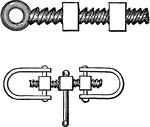
Screw with Lever Arm
"The power is generally applied by a wheel or a lever, and moves through the circumfrence of a circle.…

Second Class Lever
"A lever is an inflexible bar freely movable about a fixed axis called the fulcrum. If the weight is…
Second-class Lever
"The second kind of lever is represented where W is the weight, L the lever, F the fulcrum, and P a…
Second-class Lever
"Two men carrying a load between them on a pole is also and example of this [second class] kind of lever.…

Second Class Lever
"A Lever of the Second Kind is one in which the weight is between the power and the fulcrum." —Quackenbos…

Second Order of Lever
In the second order of levers, the weight is between the power and the fulcrum.

Railroad Semaphore
"Railway Semaphore. a, lever, which operates both b, blade, and c, lantern." -Whitney, 1911
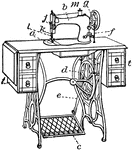
Singer Sewing Machine
"Singer sewing-machine. a is the frame and cloth-plate or bed-plate; b, arm; c, treadle; e, pitman;…
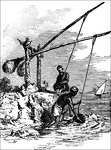
Shadoofs, Two Men Raising Water
"A contrivance extensively employed in Egypt and the East, generally for raising water. It consists…

Simple Lever
"Any rod, or bar, which is used in raising a weight, or surmounting a resistance, by being placed on…
Simple lever system
"Suppose that A is the lever, B the fulcrum, D the weight to be raised, and C the power. Let D by considered…
Simple Lever System
"Suppose the weight, B to be sixteen pounds and suppose the fulrum to be placed so near it, as to be…
Simple Lever System
"But let the fulcrum be moved along to the middle of the lever, with the weight of sixteen pounds still…
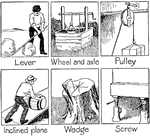
Simple Machines
Illustrations showing the six mechanical powers: lever, wheel and axle, pulley, inclined plane, wedge,…
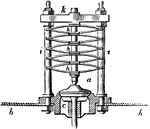
Lever Spring Safety-valve
A form of spring safety-valve, in which a series of bent springs h h h are placed alternately in opposite…
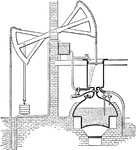
Newcomen Atmospheric Steam Engine
An illustration of Newcomen atmospheric steam engine. The boiler heats the water to build up steam in…
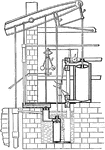
Watt's Final Steam Engine Design
The illustration showing Watt's final steam engine design. The engine is fitted with series of rods…

Steelyard
"The Steelyard is more portable then the ordinary balance. It consists of a lever, AB, moving round…
Steelyard
"When bodies of unequal weight are supported by the arms of a lever, they will balance each other whenever…

Steelyard
"The steelyard is a kind of balance, which, though not so sensitive as the one being described above,…

Suction-pump
A suction-pump with the upward and downward movement of the piston being effected by means of a lever.
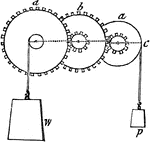
System of Wheels
"System of Wheels.—As the wheel and axle is only a modification of the simple lever, so a system…

Third class lever
"A lever is an inflexible bar freely movable about a fixed axis called the fulcrum. If the power is…

Third-class Lever
"In the third and last kind of lever, the weight is placed at one end, the fulcrum at the other end…
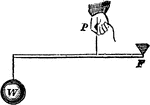
Third Class Lever
"A Lever of the Third Kind is one in which the power is between the weight and the fulcrum." —Quackenbos…

Lever Safety Valve
An illustration of a lever safety valve. "Suppose the valve A is just suppose to open when the steam…
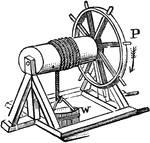
Wheel and axle
"The wheel and axle consists of a wheel united to a cylinder in such a way that they may turn together…
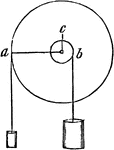
Wheel and Axle
"This figure represents the machine endwise, so as to show in what manner the lever operates. The two…
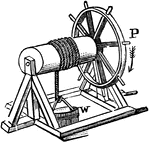
Wheel and Axle with Rope and Bucket
"The wheel and axle consists of a wheel united to a cylinder in such a way that they may turn together…
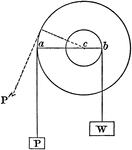
Wheel and Axle
"Considered as a lever, the fulcrum is at the common axis, while the arms of the lever are the radii…
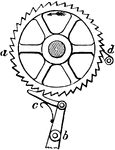
Ratchet Wheel
A wheel with pointed and angular teeth, against which a ratchet abuts, used either for converting a…
